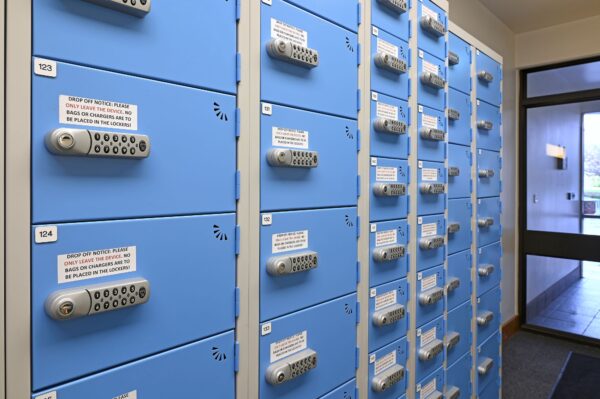Background
Coventry and Warwickshire Partnership NHS Trust serves a wide geographical area. Its responsibilities include seven to eight ‘hub sites’, but collectively it stretches to 70 community-based hospital sites in and around Coventry and Warwickshire.
The Coventry & Warwickshire IT Collaborative are the people who help the Trust with all their IT needs. They support around 5,500 users, including nurses, clinical staff, and corporate teams, who rely on a variety of equipment such as desktops, laptops, docking stations and smart devices.
Wasted time
With such a large customer base, the traditional ‘appointment-based’ system was starting to feel slow and inefficient.
Should anyone need something done to their equipment, they had to book an appointment and deliver it in person to the IT department. Sometimes people simply turned to the department. That usually meant a long drive for a one-to-one meeting at IT Head Office. Once there, they would wait, sometimes hours, for their equipment to be sorted.
Aware that this system was wasting people’s valuable time, the department started searching for an alternative solution.
Then COVID struck
When COVID hit and Working From Home (WFH) was introduced, all pressures on the service jumped to another level.
With more people working from home, there was a big surge in service requests as well as a wealth of new equipment orders. Social distancing restrictions made one-to-one appointments a risk. Plus there was the added need to enable its own IT staff to work from home.
Faced with such huge pressures to their service, the IT department made the decision to pull their new project forward to 2020.
Challenges in brief
Inconvenient equipment repairs: Clinical and corporate staff often had to travel long distances and wait at the IT department for equipment repairs, leading to lost productivity and frustration.
Resource constraints: The IT department lacked the resources to provide a dedicated engineer for one-off jobs, and the traditional support model was not scalable.
Then COVID added these:
High demand for IT support: With the onset of the pandemic, there was a surge in service requests and new equipment orders as staff transitioned to remote work. This placed a strain on the IT department, which was not equipped to handle the increased demand while following social distancing guidelines.
Need for a safe, contactless solution: The pandemic required a safer method for equipment handling that minimised face-to-face interactions and ensured compliance with health guidelines.

Opportunity
In response to the situation, Coventry & Warwickshire IT Collaborative contacted Garran Lockers. As the locker provider for the Trust’s estate department, Garran was able to provide personal lockers for the team to place the IT equipment in need of attention.
However, the IT Collaborative knew they needed something more innovative. They needed a solution that allowed users and IT staff to access the lockers and drop-off equipment without the need for face-to-face contact.
The answer was the Lowe & Fletcher Remote Allocation System (RAS). RAS is a user-friendly code management software that enables people to remotely manage access to all of their locks without the need to be on site.
Solution
RAS lockers were installed at six key sites across Coventry and Warwickshire.
All lockers were centrally located within the sites at: IT headquarters, Coventry city centre, Nuneaton, Marston Green, and Warwick and Rugby to provide easy access points for all staff across the area.

How it works
Integration with Helpdesk portal
When a staff member needs equipment repair or service, they complete a self-service form that raises a ticket in the helpdesk system. An engineer then assesses the issue and determines whether it can be resolved remotely or if the equipment needs to be dropped off at a locker to investigate further.
It’s more efficient
If a drop-off is required, the engineer allocates a locker at the most convenient location for the user. The staff member receives an email with a PIN and instructions, ensuring a smooth and contactless handover.
IT technicians are notified of the locker status and can plan their pick-up quickly and easily. Should a drop-off not be made or collected within two weeks, RAS will close the ticket.
Far more flexible
RAS portal and lockers are available 24/7. This allows staff to drop off and pick up equipment at any time, regardless of shift patterns. This flexibility has been particularly beneficial for crucial staff and engineers working on tight deadlines.

Benefits in brief
Operational efficiency: The new system simplified the process of equipment repairs, reducing the need for staff to wait in line at the IT department. Engineers can now focus on more critical tasks and manage their time more effectively.
Improved scalability: The solution is easily scalable, with the ability to add new lockers and users as needed. The RAS portal is user-friendly, making it simple to onboard new staff and manage locker availability.
Enhanced productivity: The lockers have significantly reduced the time spent on equipment drop-offs and collections. That means no more queuing in the IT department, while important members of staff are able to use their time more efficiently.
Risk reduction: By minimizing face-to-face interactions and allowing for sanitization of equipment, the RAS lockers contributed to safer operations during the COVID-19 pandemic.
Positive feedback: The flexibility and convenience of the RAS lockers have been well-received by staff, providing peace of mind during a challenging period.

Conclusion
The introduction of RAS lockers at Coventry & Warwickshire Partnership NHS Trust has revolutionised its IT service delivery.
Instead of an outdated, appointment-only system, RAS has helped Coventry & Warwickshire IT Collaborative streamline its services, yet still boost productivity. The new system provides a scalable, efficient and safe solution that meets the needs of a geographically dispersed workforce.
Beyond the challenges of COVID, the RAS system is still in full use and continues to deliver significant improvements in operational efficiency, productivity and staff satisfaction.

